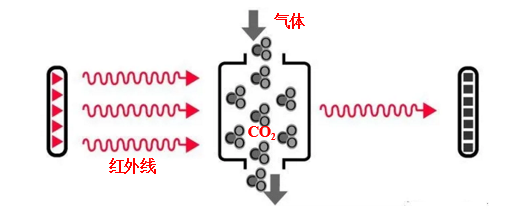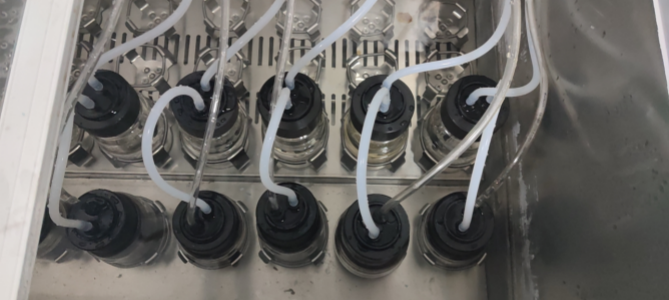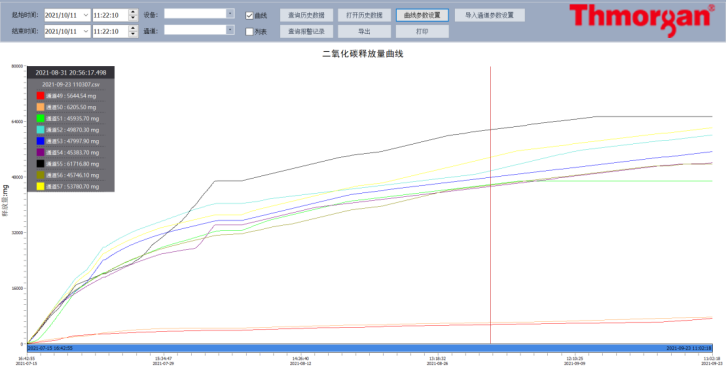Product
All categories

Hydroponic infrared biodegradation instrument
Model :T9000
Product use
1. Meet the test standards of GB/T19276.2-2003;
2. Meet the test standards of GB/T33616-2017;
3. Meet the test requirements of GB/T40612-2021;
4. Meet the test requirements of GB/T40367-2021;
5. Meet the ISO14852-1999 testing standards;
6. Meet the testing standards of ISO19679-2020;
7. Can be used for activated sludge biodegradation detection;
8. Can be used for bio-based biodegradability detection;
Product features
1. Fully meet the test requirements of GB/T 19276.2 standard;
2. The design method of water-based culture and open oxygen supply is adopted to simulate a strong aerobic environment;
3. 9-channel independent infrared detection, real-time online measurement of carbon dioxide release;
4. Wide detection range, the highest detection limit can reach 5000ppm;
5. Double display of carbon dioxide concentration and accumulation, which can be derived in the form of charts or curves;
6. Air bath temperature control, room temperature -90℃, temperature adjustment accuracy ±0.1℃;
7. Magnetic stirring system: provide long time stirring;
8. Cloud platform detection, real-time online observation of data and curves;
Product principle
This experiment system simulates the process of biodegradation of bio-based materials under aerobic hydroponics. In the aerobic hydroponic environment, microorganisms consume oxygen and produce carbon dioxide, water and other inorganic substances. The generated carbon dioxide is monitored in real time by high-precision infrared sensor, and the real-time concentration of detected carbon dioxide is integrated with the flow rate and time, so as to calculate the carbon dioxide release from the biodegradation of the sample. The biodegradation rate is the percentage of the carbon dioxide released by the sample biodegradation and its theoretical carbon dioxide release.

Product parameters
1. Working conditions:
1.1 Power supply voltage: AC 220V±10% 50Hz single-phase;
1.2 Working temperature: 15 ~ 30℃;
1.3 Relative humidity: ≤ 80%;
1.4 Power: 4KW;
1.5 Appearance dimensions (L×W×H) : 1500mm×900mm×900mm
1.6 Gross weight: 180KG.
2. Oxygen supply system
2.1 Air supply mode: continuous aeration oxygen supply, built-in air supply pump;
2.2 Air pump control: the air pump is divided into 9 channels, each channel has an independent switch;
2.3 Gas flow adjustment range: 50-300mL /min;
2.4 With 9 mechanical flowmeters to adjust the flow rate;
2.5 With 9 electronic flowmeters to collect flow rate;
3. Temperature control system:
3.1 Temperature control mode: air bath;
3.2 Set temperature range: room temperature -90 ℃, step by 0.1℃;
3.3 Temperature control accuracy :≤±0.1℃;
3.4 Temperature control box top sliding door, easy to operate;
4. Reaction system
4.1 Number of channels: ≥9;
4.2 Mixing method: 9-channel magnetic mixing;
4.3 Reaction mode: liquid reaction;
4.4 Volume of reaction bottle: 500ml;
4.5 Decarbonization system: Yes;
4.6 Condensing system: Yes;

5. Test the system
5.1 Detection method: infrared carbon dioxide detection;
5.2 Number of infrared probes: ≥9
5.3 Display mode: synchronous dual display of carbon dioxide concentration and total amount;
5.4 Detection range: 0-5000ppm;
5.5 Resolution: 1ppm;
5.6 Data collection cycle: up to 1 second once, seconds, minutes, hours can be freely selected;
6. Software control system
6.1 Software control system with independent intellectual property rights;
6.2 Software can collect data and generate real-time data curve;
6.3 Bearer system: professional operating system such as win7/8/10;
6.4 Data storage: It can be stored in real time in the experiment;
6.5 With a cloud platform, data can be accessed remotely;
6.6 USB ports: 3.

Standard configuration
|
erial number |
name |
quantity |
unit |
remark |
|
1 |
host |
1 |
Taiwan |
|
|
2 |
Reaction flask |
9 |
entries |
|
|
3 |
Decarburization bottle |
9 |
entries |
|
|
4 |
Condensing bottle |
9 |
entries |
|
|
5 |
Dehumidifier bottle |
9 |
entries |
|
|
6 |
Connecting hose |
1 |
Set of |
|
|
7 |
software |
1 |
Set of |
|
|
8 |
Rando |
1 |
Set of |
|
Examples of experiments
This is the experimental result of determining the biodegradability of a certain sample by using T9000C hydroponic biodegradation instrument and referring to the method standard of GB/T19276.2-2003. The test period is 49 days. At the end of the test, the average degradation rate of cellulose is 89.41%, and the curve of various product groups is flat, and the growth is basically over. The experimental design and experimental results are as follows:
Table 1 Experimental design
|
|
1 |
2 |
3 |
4 |
5 |
6 |
7 |
8 |
9 |
|
Inoculum |
300ml |
300ml |
300ml |
300ml |
300ml |
300ml |
300ml |
300ml |
300ml |
|
Cellulose |
|
|
|
2.0g |
2.0g |
|
|
|
|
| Sample 1 |
|
|
|
|
|
2.0g |
2.0g |
|
|
|
Sample 2 |
|
|
|
|
|
|
|
2.0g |
2.0g |

Figure 1 CO2 emission curve




